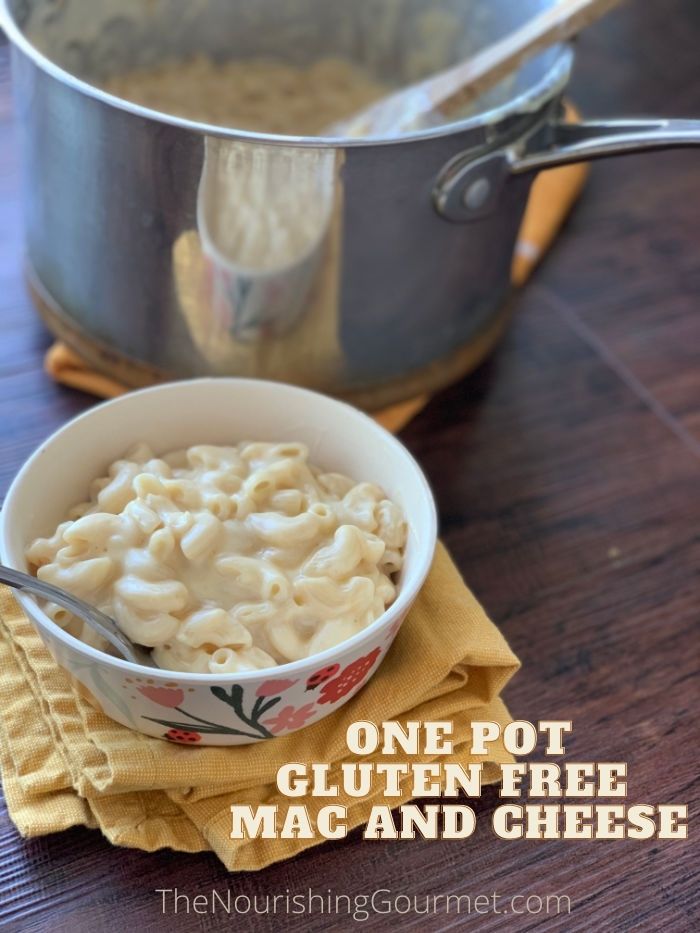
This one-pot super creamy and delicious gluten-free mac and cheese is finished in less than 15 minutes. It’s so simple!
My kids aren’t really into sandwiches, unfortunately, but this pasta dish is something they love as a last-minute meal. If my husband has an evening meeting, and I’m eating a dairy-free (THM) meal, I can whip this together with minimum fuss. Since I homeschool our kids currently, they also ask for it for lunch.
You only need a few basic ingredients: Milk (I use whole), chicken broth, pasta, cheese, and salt. That’s it!
How it works: Instead of boiling the pasta in water and making a cheese sauce, this recipe boils the pasta in the chicken broth and milk, and the starch released from the pasta thickens the sauce as it cooks. It’s a little magical. To compare it to a more traditional mac and cheese method, check out this recipe (also gluten-free, but using goat cheese!).
Notes:
- You can have fun trying this with different cheeses. Our favorite so far is half Colby Jake and half Pepper Jake. Yum!
- You can use all milk instead of half broth. I love my homemade broth, so this is a chance to get some more in. But I also think the flavor is better and more complex with half broth. If you are using homemade do pre-salt it, otherwise it will be too bland.
- Pick a gluten-free pasta brand you know stays together well for this recipe, and cook until just tender. Because different brands may vary in how much starch they give off, you may need to adjust the amount of liquid if it ends up too liquidy. Just remember that you can give it a quick boil at the end to remove excess liquid, if necessary.
One-Pot Gluten-Free Mac and Cheese
- 12 oz dry gluten-free pasta (shells, elbows, or other short pasta) (about 4 cups of dry pasta) I tested this with Field Day Gluten-free Brown Rice pasta
- 2 cups of whole milk
- 2 cups of chicken broth (homemade or storebought)
- 2 teaspoon salt
- 2 cups of shredded cheese (my kids like Colby, or one of our favorites, Pepper Jack! I like to use half of each. Use cheddar for a more traditional flavor)
Directions
Place the pasta, milk, chicken broth, and salt in a medium or large pot. Bring to a low simmer, and simmer until just tender (for the brand of brown rice pasta I use, that took about 7-10 minutes. Look at the package and follow their time suggestions).
Because you are using less liquid, you will need to stir more often to make sure the pasta isn’t sticking on the bottom of the pan. Not quite constantly, but pretty often, especially as it begins to cook.
Once the pasta is getting close to being done, you can turn up the heat a little to boil away any extra moisture there is, if necessary (again, making sure you don’t let the pasta stick on the bottom of the pan). When it looks thick enough to be a sauce-y mac and cheese, turn off the heat, and add your cheese. Stir in (it should melt easily), and let sit for a minute or two, and serve! The sauce will continue to thicken as it sits.
Latest posts by KimiHarris (see all)
- 2 Ingredient Peppermint Bark - December 21, 2022
- Herbal Hibiscus Lemonade (Keto, THM) - March 16, 2022
- Creamy Curry Red Lentil Soup - December 8, 2021
I made this tonight with goat milk and goat pepper Jack, and it was the best Mac n cheese I’ve ever made. It’s the only one the whole family has enjoyed since going gluten and cow dairy free 3 years ago. It came out super creamy and delicious. Thank you for the recipe!
Wonderful! So glad you enjoyed it.
Why does this recipe include 2 TEASPOONS of Salt. Its not healthy given that broth maybe salted and cheese contains salt.
Comfort food not cardiac event inducing food.
Hi Dee Lite,
If your doctor recommended you be on a low-salt diet, absolutely cut out the salt on this recipe. Because the topic of how much salt is optimal is controversial and likely individual, I don’t follow specific salt guidelines for any of my recipes, but go solely by taste. This is not a low-salt website, so I recommend finding recipes elsewhere if that’s the type of recipes you need. Here is a helpful link to research on the topic of salt/low-salt, showing just a tiny sliver of the research out there on the topic. https://www.healthline.com/nutrition/6-dangers-of-sodium-restriction#TOC_TITLE_HDR_3